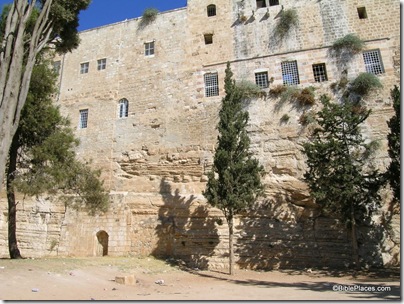The current issue of Biblical Archaeology Review (Jan/Feb 2009) includes an article by Ehud Netzer on the size and location of the Antonia Fortress (teaser here). Built by Herod the Great, this imposing structure both protected the Temple Mount on its vulnerable northern side and it served as a convenient monitoring station for potential uprisings in the Temple area. When Paul was accused of bringing a Gentile beyond the Court of the Gentiles, a riot began. Paul’s life was spared by Roman officials who arrested him and took him to the Antonia Fortress (Acts 21:27-22:29).
Netzer is a renowned scholar, whose work on the Herodian sites of Jericho, Herodium, Caesarea, Jerusalem and elsewhere has led some to dub him “Mr. Herod.” He realized a lifelong dream in 2007 with the discovery of King Herod’s tomb. He has not excavated in the area of the Antonia Fortress because the Muslim authorities forbid any scholarly activity on the Temple Mount.
Leen Ritmeyer, a Temple Mount scholar, yesterday posted a response to Netzer’s article on the Antonia Fortress. Ritmeyer believes that Netzer is mistaken both with regard to the size and shape of the building. As always, Ritmeyer has beautiful and helpful illustrations. The second diagram in his post reveals the existing remains of the fortress (in yellow). The photo below shows the rock scarp and some of the Herodian masonry (on right).

5 thoughts on “Remains of Antonia Fortress”
Hi Todd. I have seen that picture of the Antonia foundations many times, but I can’t figure out exactly where is it. Can you tell me?
Al – this was taken near the northwestern corner of the Temple Mount. The remaining foundations of the AF are on the right side of this photo; the minaret is at the northwest corner of the TM.
Thanks Todd. For some reason, I got it in my head that it was a part of the Northern edge of the Antonia, which would have put it outside the TM. This makes more sense.
Very annoying, however, that several times I’ve been close enough to hit the area with a rock and never took a close look or got a picture. I guess it’s good to continue to have reasons to go back.
BTW, I do find that the internet has created a fascinating way for scholars to debate ideas with such immediacy.
Before, if someone read an article they wanted to comment on, they wrote a letter that may have wound up in the publication several months later. Any such “discussion” that involved several exchanges could easily take a year. Now, it can be done in a matter of days and span the whole globe. Amazing, really.
In Israel in 2017, we saw what appeared to be Roman columns on the north side of the Temple Mount, and were told that had been the Antonia, but we weren’t allowed to go near it. Can you tell me why? On your picture, it looks like someone is using the ruins, with modern windows in the building built on the foundation. Thanks.
The building above the rocky escarpment is the Omariyya boys school. Sometimes it is possible to enter into the school and view the Temple Mount from the north. As for approaching anything on the Temple Mount, it just depends on who is around to be difficult. In general, they don’t want anyone doing anything related to anything pre-Muslim, as that can undermine the Muslim claim to the site.